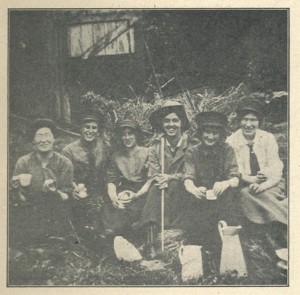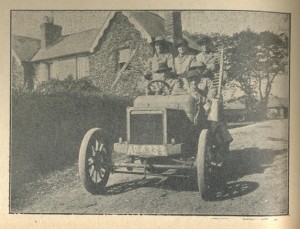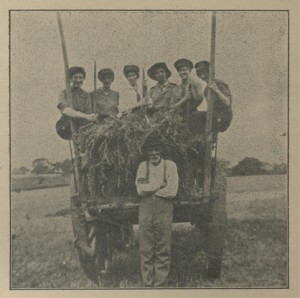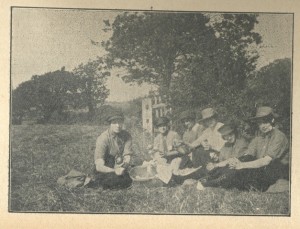 By January 1915 over 100,000 British farm-workers had gone to war, and farmers were finding it hard to produce enough food for the country. Through various voluntary societies some women began to volunteer to help with farm work but this was still not enough to make much of a difference. Throughout 1915 and 1916 efforts were made by voluntary organisations, such as the Women’s Defence Relief Corps, which in Bexhill was organised by Mrs Tuckwell of “Linkwell”, Old Town, as well as by the Government through the War Agricultural Committees of the Board of Trade, to encourage women to offer their services on the land and to persuade farmers to accept them.
By January 1915 over 100,000 British farm-workers had gone to war, and farmers were finding it hard to produce enough food for the country. Through various voluntary societies some women began to volunteer to help with farm work but this was still not enough to make much of a difference. Throughout 1915 and 1916 efforts were made by voluntary organisations, such as the Women’s Defence Relief Corps, which in Bexhill was organised by Mrs Tuckwell of “Linkwell”, Old Town, as well as by the Government through the War Agricultural Committees of the Board of Trade, to encourage women to offer their services on the land and to persuade farmers to accept them.
When conscription was introduced in March 1916, more and more men were taken off the land and sent to the Front. The result was that by the end of the year food production had almost reached crisis point, and a way had to be found to replace the men if the country was not to starve. In January 1917 the British Board of Agriculture set up a new “Department for Food Production” under Director, Meriel Talbot. In March she established a civilian organisation entirely staffed and run by women called the “Women’s Land Army”. This organisation recruited young women over 18 years of age and trained them for four weeks in farm work. Training centres and special short courses at existing agricultural colleges were set up to provide training and an introduction to working on the land for women who would become known as the “Land Girls”.
A national appeal was made and Village Registrars were enlisted to keep registers of local women farm workers so that farmers knew who was available and what their skills were. Women’s War Agricultural Committees were set up in each county to encourage farmers to employ WLA recruits after their initial training.
‘Land Girls’ took on milking, market gardening, and the care of livestock. They learned to work with horses as carters and plough women, cut timber, and carried out general work on farms. They were paid 18 shillings a week, which was increased to 20 shillings once they passed an efficiency test. Between March 1917 and May 1919, 23,000 women became official members of the Women’s Land Army, a small but significant part of the 300,000 women who by 1918 were working on the land.
In November 1919, the Women’s Land Army was officially disbanded.
A Bexhill Girl’s Training Experience
In the “Bexhill Chronicle”, dated 30th June 1917 a young unidentified Bexhill recruit gave an idea as to what that training involved.
She was sent many miles away from her home to a large training farm with 1,200 acres of land. There were two large farmhouses, so the farmer gave up one for the use of the girls who were training there. It was situated in the middle of a large Park on a high point, so she said, they “enjoyed the beautiful fresh air and lovely scenery all round us”.
For the first week, like all the other recruits, she was mainly employed in pulling up weeds in the wheat fields but after that, from 10 o’clock ion the morning until 1 o’clock in the afternoon they were out in the fields “working with the horses, doing the ploughing, harrowing and rolling.”
They went out in the morning, taking their breakfast with them, as did the men, and they were allowed to ride the horses down to the field – “we often had a couple of miles to go before starting our work, if we were working on the field at the farthest end of the farmers boundary. We enjoyed the ride there and back on the horses. Sometimes we took a cart with us, and the girls all rode in that way down to work and back again, with one of us driving. We found the work very interesting, and we soon got used to the horses”.
She goes on to say, “The harrows were very heavy and required three horses to drag them over the rough ground. In driving these horses one has to be very careful in turning them round at each end of the field, as they are inclined to kick over the traces, and once a horse gets his leg over he begins to kick and stamp and upset the other horses, but we soon got into the knack of driving them properly, and the men told the farmer that we were getting on famously. He was very pleased with our work and said that he hoped the girls would keep on coming to be trained for land and farm work.”
“We had dinner at one, and at 2.30 we started work again. Some of us went milking, others back to the field to drive the rollers, horse-hose, etc., and some were sent to the stables to learn how to harness and groom the horses. We found it difficult to put on the horses collars, they were so heavy, it was by watching one of the men that we discovered how they got their collars on so easy. This man put the collar just over the horses nose, held it there, and just said, ‘shove’ and, bless me, if that good old horse didn’t shove his head straight through the collar and it was on in a jiffy. We didn’t forget that little bit, it amused us highly.”
“We had several adventures with the cows. One day I was busy milking one of the cows, when all of a sudden she lifted her leg and down came the hoof on my foot. It made me jump so I nearly upset the pail”
“Some cows are very quiet. We had a special bull and cow we named ‘Romeo and Juliet,’ they were two lovely animals. When we went to fetch Juliet in to be milked, she generally led us a fine dance all round the field and finally got behind the bull for protection, but we persevered and in the end Juliet used to come along as quiet as a lamb.”
“We considered it a great treat to take the horse and cart into the village, which was 2 miles away from our farm, and fetch back anything that was wanted. Sometimes we had to take a horse to be shod and that meant a nice ride for one of us on horseback. Of course we had to take it in turns as there were 10 of us training at a time. We had a young lady instructor who taught us milking, etc., while the men on the farm told us the fieldwork and the looking after of the horses.”
 “We were finished at 5.30 each evening. They supplied us with very good food and plenty of it. As the farmer said, girls working on the land need feeding.”
“We were finished at 5.30 each evening. They supplied us with very good food and plenty of it. As the farmer said, girls working on the land need feeding.”
The Land Girls’ uniform usually consisted of a pair of grey corduroy breeches, and overalls that were fastened at the waist with a belt, and reached down to the knees, a pair of good solid black high boots finished off neatly at the top with a band of leather, fastening at the side with two buckles, and a brown felt hat.”

